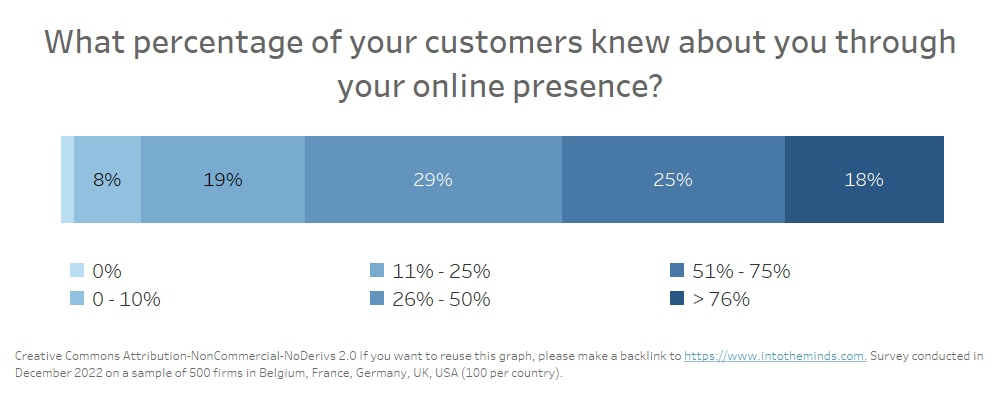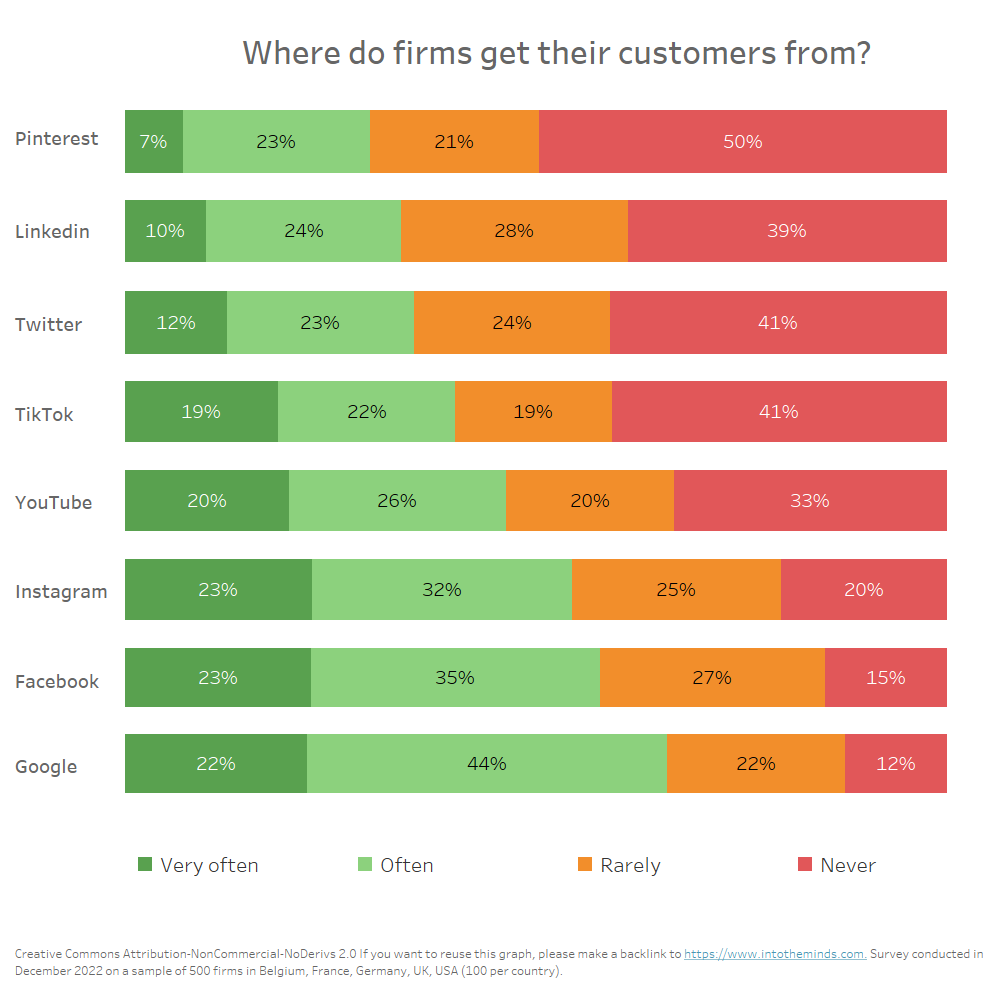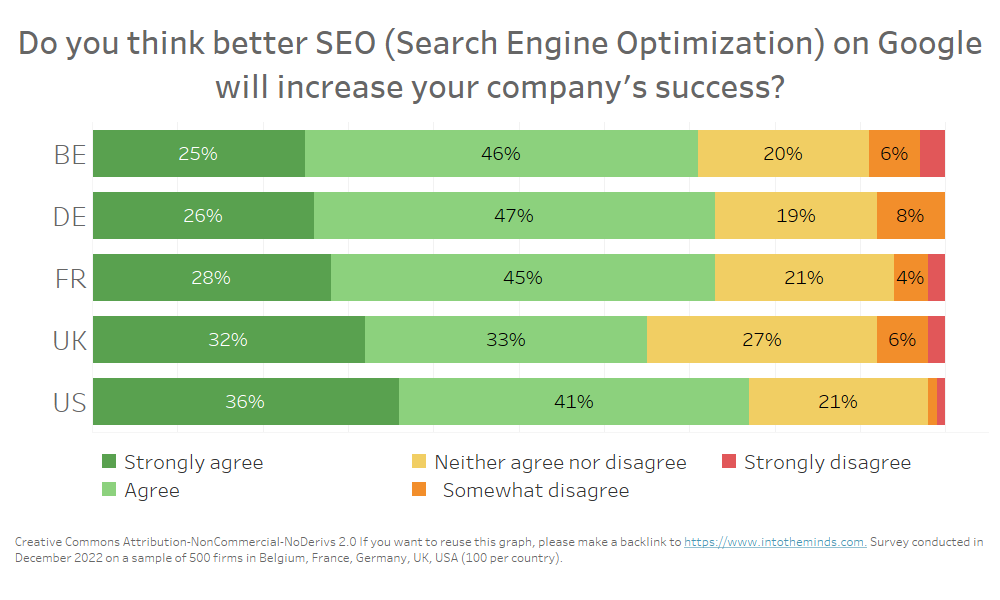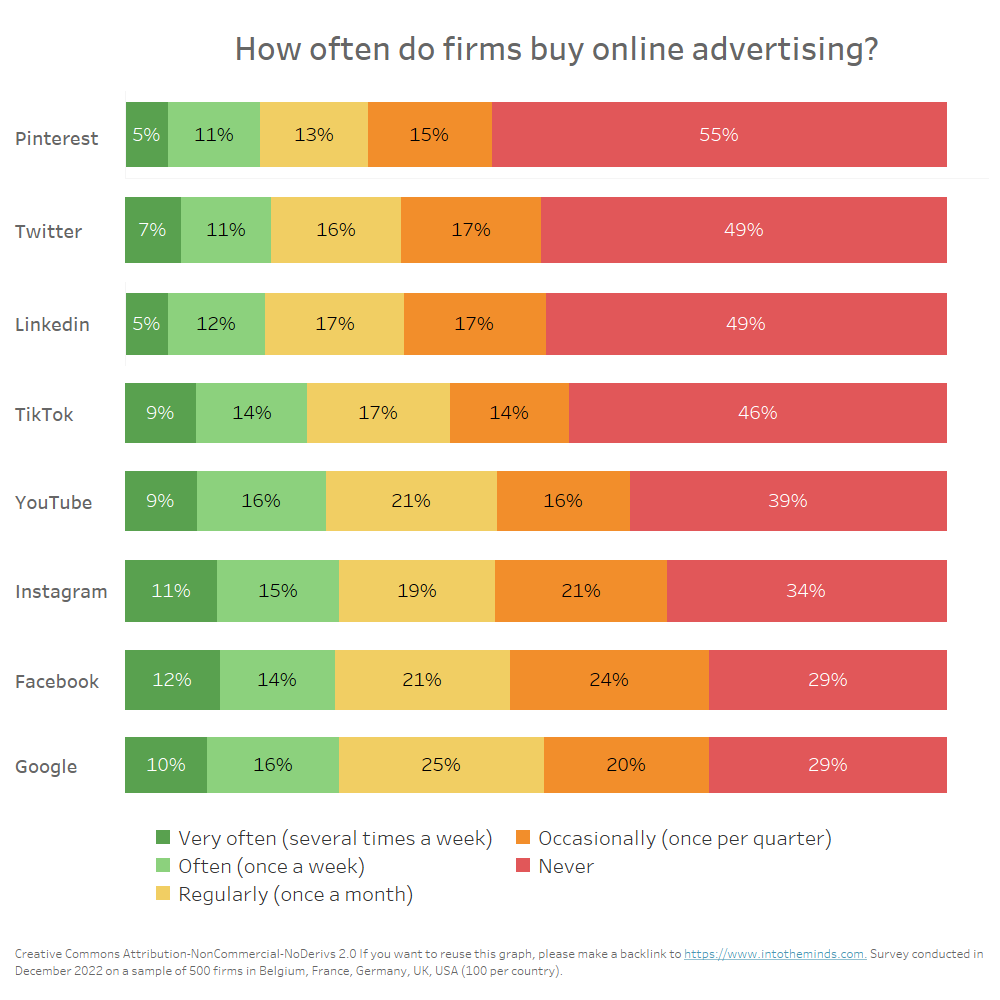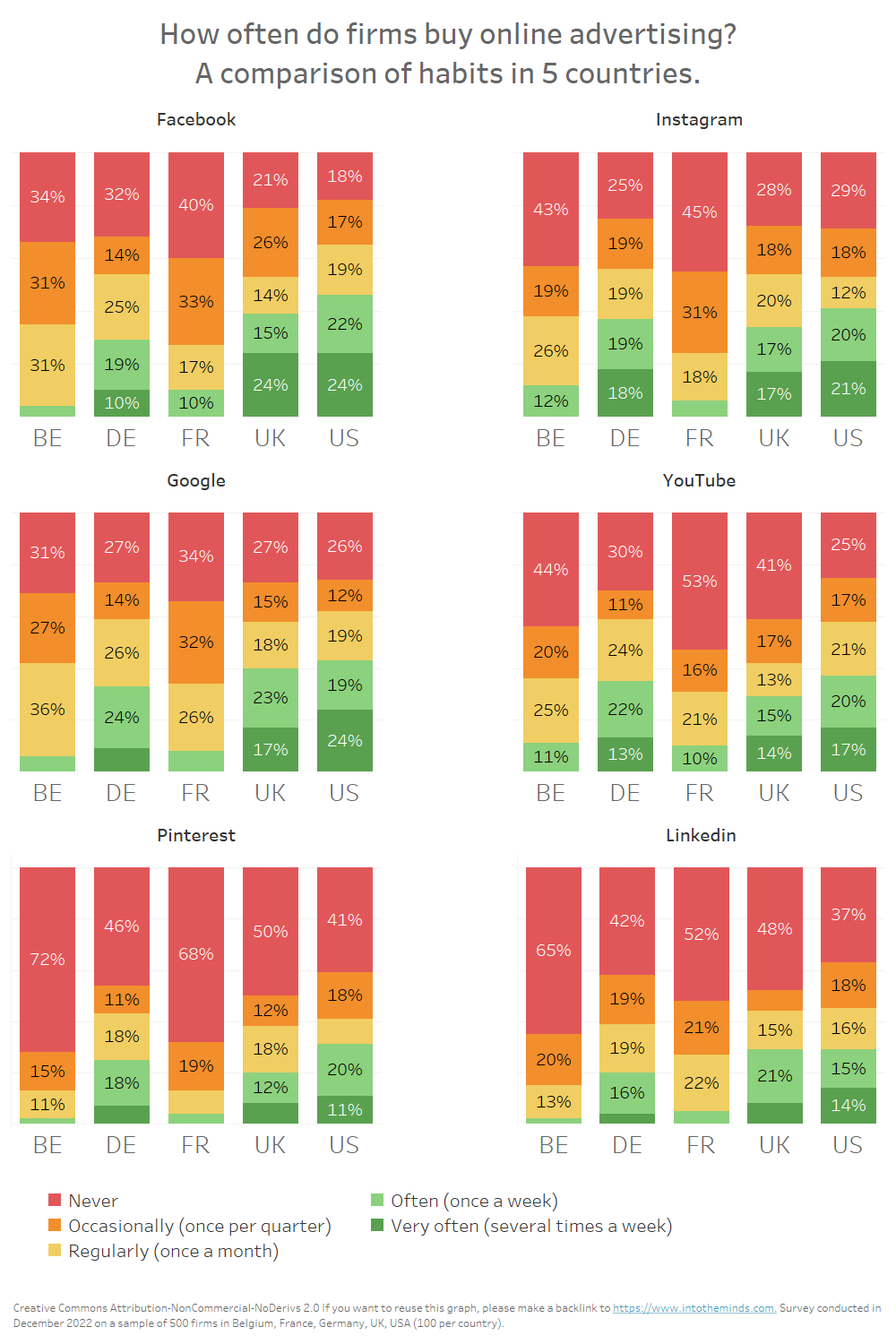Regarding online marketing, not all companies are at the top. Online is the Achilles heel of many of them, especially SMEs. The research we publish today provides a better understanding of online advertising and customer acquisition practices via social networks. It follows the one we published on lead generation. We identify interesting differences between countries as the research we share was carried out in the US, France, Germany, Belgium, and the UK.
Feel free to ask questions in the comments and contact us for any research project.
Contact our market research agency
Marketing online: statistics 2023
- 18% of the companies consider that more than 3/4 of their customers knew them thanks to their online presence
- About 2/3 of the managers surveyed establish a positive correlation between SEO and the success of their company.
- 26% of companies buy digital advertising on Google often or very often
- Only 15% of companies have never found a customer via Facebook. 58% of companies surveyed say they find customers there frequently or very frequently.
- Only 18% of American companies have never used paid advertising on Facebook, compared to 40% in France, 32% in Germany, and 34% in Belgium.
- The proportion of companies not advertising on Google is relatively similar in the US (26%), UK (27%), Germany (27%), and Belgium (31%)
Summary
- Online channels, the gateway to the customer experience
- Ranking of the best online channels to find customers
- Digital advertising: companies’ habits in 2023
- Digital advertising: companies’ buying habits by country
1. Online channels, the gateway to the customer experience
When it comes to Omnichannel Marketing, online should not only be considered the channel where the sale is carried out. What our survey shows is that it is also a gateway. For 43% of the companies surveyed, thanks to their online presence, they have found the majority of their customers. 18% of the companies even consider that more than 3/4 of their customers discovered them thanks to their online presence.
These two statistics remind us that the customer experience is complex and that purchasing decisions are often made by jumping from one channel to another. Each customer experience is unique.
These numbers tell us that inbound marketing is a mechanism many more companies could benefit from. If the customer experience starts online for most of those who will become customers, you have to take care of your online presence. No company can do without a website, and no manager can do without online marketing and SEO training.
2. Ranking of the best online channels to find customers
Social networks are seen as an inexhaustible source of leads by those who do growth marketing. So, we wanted to understand the reality of companies. We asked how often they found customers via the 7 most popular social networks. To have a basis for comparison, we added their website to the list. The results are quite surprising.
First of all, let’s note the hierarchy of social networks. Not all social networks are equal when it comes to finding customers. We have classified them below in ascending order of effectiveness. So, the most effective networks, or at least the ones through which the most customers come, are at the bottom of the chart. Pinterest is, therefore, the least frequently cited social network for acquiring customers. Facebook is the most frequently cited.
Let’s look at the figures:
- 50% of companies surveyed have never found a customer via Pinterest.
- Only 15% of companies have never found a customer via Facebook.
- LinkedIn is not a social network that provides customers. Indeed, 2/3 of the companies surveyed have never or rarely found customers via this channel.
- Whatever the social network, the search engine (Google in this case) remains the number one entry point for customers. Only 12% of the companies say they have never found a customer through this channel (probably because they don’t have a website, which is, unfortunately, still very common among VSEs and SMEs). They are 66% (2/3) to look for their customers frequently or very frequently.
- Facebook remains, despite its decline, the most frequently cited social network to find customers. 58% of the companies surveyed say they find customers there frequently or very frequently. This is twice as much as Pinterest.
- Note that Meta trusts the top spots since Instagram ranks just behind Facebook. 55% of executives say they find customers there frequently or very frequently, and only 20% of companies have never found customers there.
Finally, there is little difference between acquiring customers via Google and Facebook. The difference for the highest frequencies (light and dark green) is only 8 points.
The dominance of Google as the customer gateway explains why respondents are so sensitive to the importance of SEO. Indeed, regardless of the country, about 2/3 of the managers surveyed establish a positive correlation between SEO and the success of their company.
As shown in the graph below, slight variations exist between countries. For the most convinced (dark green), there is an 11-point difference between Belgian and American executives. This reflects the lesser degree of digitalization of the Belgian (and European in general) economy compared to the American economy.
3. Digital advertising: company habits in 2023
Since some social networks seem so effective at finding customers, the other question was whether companies buy advertising there. As in the previous question, we asked the same question for Google to have a basis for comparison.
The first conclusion is that the purchase of digital advertising remains marginal for all the companies surveyed. Half of the companies surveyed have never purchased digital advertising on Pinterest, Twitter, or LinkedIn. And only 26% buy regularly or very regularly on Facebook or Instagram.
The purchase of digital advertising remains marginal on the scale of all the companies surveyed.
The hierarchy noted in the previous analysis (“Where do customers come from?”) is reflected in the buying habits of digital advertising. If Facebook and Instagram are the leading social networks, we can nevertheless see that in terms of purchase frequency, the first 4 channels are in close proximity. The percentage of executives who say they buy online advertising often or very often is as follows:
- Google: 26%
- Facebook: 26%
- Instagram: 26%
- YouTube: 25%
4. Publicité digitale : habitudes d’achats des entreprises par pays
In this last part, we analyze digital advertising buying habits according to the country. As a reminder, we surveyed 500 company managers of all sizes in 5 countries: Belgium (BE), Germany (DE), France (FR), the United Kingdom (UK), and the United States (US). The results should be taken cautiously as the sample is limited to 100 companies per country. Nevertheless, they already show some trends.
American companies have tested digital advertising more often
Regardless of the online channel, the percentage of companies that have never purchased digital advertising is the lowest in the United States. For Facebook, only 18% of American companies have never used it. In France, 40% have never used it; in Germany, 32% and in Belgium, 34%.
These differences can also be seen on YouTube, LinkedIn, and Pinterest.
Google gets everyone on board
The differences observed previously on social networks are much smaller in the case of Google. The usage is more established for a longer period. For this reason, the proportion of companies not advertising on Google is relatively similar in the US (26%), UK (27%), Germany (27%), and Belgium (31%). Only France stands out again, with 34% of the responding companies not buying advertising on Google.
French and Belgian managers are behind
Finally, we must admit that 2 countries are a little behind: Belgium and France. From Facebook to LinkedIn to Google, the frequency of online advertising purchases is significantly lower in these two countries.
Posted in Research.
